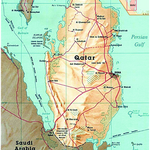Qatar’s Drinking Water
Qatar is a peninsular, a desert with a long shoreline along the Persian Gulf Sea.
Until the mid-20th century, the country’s only known source of water was the groundwater aquifer (a body of permeable rock which can contain or transmit groundwater).
The only source of freshwater was found between the tertiary marine limestone aquifers.
A low number of storms in the Arabian Peninsula led to the aquifers being depleted. This made Qatar’s water security problems in the second half of the 20th century even worse.
How Safe Is the Tap Water in Qatar for Drinking?
The water from kahramaa (government supply) is excellent. The issue in Qatar (and throughout the region) is the lack of proper maintenance by property managers for local storage systems. Each residential compound or apartment has a storage system or water tank on the buildings, but property managers or homeowners may neglect to cover or clean these tanks regularly.
In some cases, Improper chemical cleaning of tanks can contaminate water with cleaning agent residues.
As a result, while the water entering the building is good, the water coming out of your tap may be contaminated.
What Contaminants Could Be Present in Qatar’s Tap Water?
While Kahramaa’s water is of excellent quality, contaminants may arise at different stages of local storage. According to research published in Environmental Systems Research, poor maintenance practices and environmental factors can significantly impact water quality. Common contaminants can include:
Microbial Contaminants: Bacteria, viruses, and fungi can thrive in poorly maintained or uncovered water tanks.
Chemical residues: Improper cleaning of water tanks can leave cleaning agents behind, contaminating the water.
Sediments and Debris: Old or dirty pipes and tanks can leave dust, sand, and rust in the water.
Algae Growth: In uncovered tanks exposed to sunlight, algae can grow and degrade water quality.
Drinking water with unsafe levels of contaminants can cause health problems such as gastrointestinal illnesses, nervous system or reproductive issues, and chronic diseases like cancer. The type of contaminant, its concentration in water, individual susceptibility, the amount of water consumed, and the duration of exposure can all influence whether or not a contaminant causes health effects.
Safe, Strategic, and Under Ongoing Scrutiny
Qatar relies almost entirely on desalinated seawater to meet its drinking water needs—over 99% of its supply is produced through high-tech reverse osmosis systems. Thanks to heavy investment by the government and Kahramaa, the national water authority, the country boasts one of the most advanced water infrastructure systems in the Gulf, including massive reservoirs that ensure up to a week of emergency storage.
Independent studies confirm that Qatar’s tap water meets international health and safety standards. However, public trust remains limited—only about 30% of residents drink tap water regularly. Concerns often stem from the taste and the condition of local storage tanks and pipes, rather than the desalination process itself.
To boost sustainability, Qatar is investing in renewable-powered desalination, reducing network water loss to under 18%, and expanding wastewater recycling for non-potable use. As climate challenges intensify across the Gulf, the nation’s approach blends high-tech resilience with a growing push for environmental responsibility.
Bottom line: Qatar’s water is safe and plentiful, but public perception and ecological impact remain key areas of focus as the nation plans for a water-secure future.
Improvements & Sustainability Plans
Leak reduction efforts: In 2023, Kahramaa achieved a water loss rate of under 18%—better than global averages—through smart leak-detection systems.
Efficiency programs: National campaigns like Tarsheed promote conservation; wastewater is reused for non-potable uses (about 75%), and RO is being expanded.
Future roadmap: Plans include expanding reverse osmosis capacity, deploying renewable-powered desalination, improving remineralization, and lowering carbon footprints.
Sources: https://www.km.qa/, https://thepeninsulaqatar.com/article/31/12/2023/water-loss-in-supply-network-reduced-to-18-in-2023, https://www.gulf-times.com/article/681466/qatar/qatar-successful-in-ensuring-drinking-water-availability-and-sanitation-kahramaa-chief, https://www.ice.org.uk/news-views-insights/inside-infrastructure/how-qatar-faced-up-to-the-water-security-challenge, https://www.science.org/do/10.1126/resource.2442131/full/Qatar_advertorial-1722936252557.pdf






